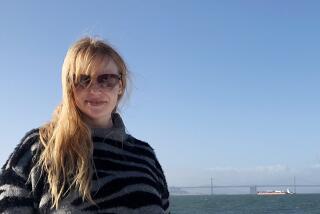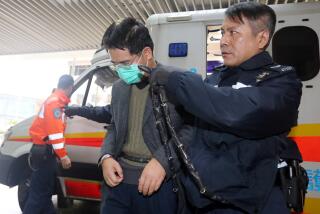Millionaire’s girlfriend was strangled at Coronado mansion before staged suicide, lawsuit alleges
Attorney C. Keith Greer held a plastic-wrapped chef’s knife in his hands, placing his fingertips on the blade where Rebecca Zahau had left her own fingerprints.
The angle of his hands, he said, made sense only if he held his hands behind his back, the blade facing up.
It was, Greer said, just as Zahau must have held the blade to try to cut the rope that her alleged killed had bound her wrists with.
Greer demonstrated the motion to jurors in San Diego County Superior Court on Wednesday in opening statements in the wrongful death lawsuit filed on behalf of Zahau’s mother, sister and other family members.
Six men and six women were selected this week as jurors in a trial expected to last a month. Strings of investigators and experts are lined up to testify for both sides.
The suit alleges Zahau was struck on the head, strangled, stripped naked, bound and tossed off a balcony with a noose around her neck by her boyfriend’s brother, Adam Shacknai.
Shacknai’s attorney, Dan Webb, told jurors in his opening statements that no evidence connects his 54-year-old client to Zahau’s death.
“There is no evidence to show that Adam Shacknai did any of those things” described by Greer, Webb said. “I believe there will be a complete failure of proof in this case.”
Greer told jurors that Shacknai, who had stayed overnight in the mansion guest house, may have sexually assaulted Zahau after she stepped out of a shower.
“She was a very energetic person. Positive. Cared about people. Bright,” Greer said of Zahau. “She ate well, was very healthy, didn’t drink or do drugs.
“Her life ended needlessly and early.”
The Zahau family’s lawsuit was filed after sheriff’s homicide investigators and the county medical examiner’s office ruled that Zahau’s July 13, 2011, death at her boyfriend’s Coronado mansion was a suicide.
Her family has firmly rejected that notion.
“My sister was murdered,” Mary Zahau-Loehner said on the witness stand Wednesday. “It is pretty obvious that she was murdered.”
Authorities who declared Zahau’s death a suicide suggested that she felt deep remorse for being in charge at the mansion two days earlier when 6-year-old Max Shacknai fell from the second floor into the foyer and suffered major head trauma.
The child, who died several days later, was the son of Zahau’s boyfriend, Arizona pharmaceuticals millionaire Jonah Shacknai and his ex-wife, Dina Shacknai.
Investigators said Jonah Shacknai left a phone message for Zahau the evening before her death, saying the prognosis for his son was grim, that at best he would never walk or talk again.
Under cross-examinination by Webb, Zahau-Loehner said she doesn’t believe Jonah Shacknai left such a dire message, and criticized sheriff’s investigators for failing to retrieve the message, which had been deleted from Zahau’s phone.
Adam Shacknai called 911 at 6:48 a.m. on July 13 to report that he had just found Zahau hanging from the balcony. While still on the phone with the 911 operator, he fetched a kitchen knife, shoved a table under her body and stood on it while he cut the rope.
He lowered her to the ground. Medics and police showed up a few minutes later.
Sheriff’s homicide detectives and the San Diego Regional Crime Lab aided Coronado police in a two-month investigation.
Webb said investigators found none of Shacknai’s DNA on the ropes binding Zahau or on the bed legs where the noose was fastened on one end.
On the other hand, the attorney said, Zahau’s DNA or prints were found on the metal bed post and other items collected as evidence.
He also said that investigators believe Zahau herself used black paint from her art supplies to scrawl a message on the bedroom door: She saved him can he save her.
“I don’t believe there will be any testimony on exactly what the words mean,” Webb said.
Greer said in the early days while Max was in the hospital, the family believed Zahau had saved the boy by trying CPR and getting her little sister to call 911.
Webb hammered at Zahau-Loehner for more than an hour about her family’s lawsuit, and why it originally alleged that Dina Shacknai and her sister Nina Romano were involved in Zahau’s death.
“That was the theory we had in our family at the time,” Zahau-Loehner said. She added that the official ruling of suicide “didn’t leave us any option but to start from scratch. We didn’t have enough evidence to exclude any of them.”
She said one neighbor reported seeing Dina Shacknai at the mansion front door before Zahau’s death. It was only later that the family attorney, Greer, found evidence that Dina Shacknai and Nina Romano were elsewhere that night, and dropped them from the lawsuit.
Repard writes for the San Diego Union-Tribune.
More to Read
Start your day right
Sign up for Essential California for news, features and recommendations from the L.A. Times and beyond in your inbox six days a week.
You may occasionally receive promotional content from the Los Angeles Times.






